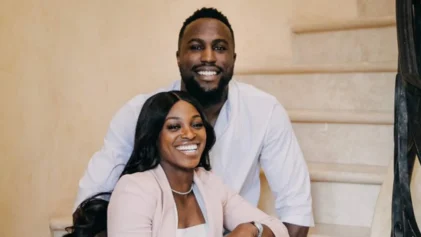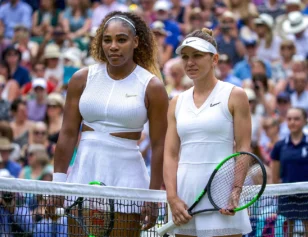The 2013 U.S. Open in Flushing, Queens has been a symbolic tournament for American tennis. Days after James Blake announced that the Open would be his swan song, the 33-year-old shot maker lost to Croatian Ivo Karlovic in the fourth round of the U.S. Open. Seven years ago, Blake was the fourth-ranked player in the world. Advancing age waged war on his skills and now it may be years before another African-American male enters the top 100.
The same day, Venus was eliminated on the women’s half of the draw. Someday, Serena Williams will also discover her tennis mortality.
On Sunday at Arthur Ashe Stadium, Serena advanced to the U.S. Open quarterfinals by mowing down No. 16-ranked Sloane Stephens in straight sets. It was the latest two Americans had met in the U.S. Open since Serena and Venus squared off in the 2008 quarterfinals. It was also an act of vengeance for Serena whose loss to Sloane Stephens in January’s Australian Open marked the first time she’d ever been beaten by a younger American in a Grand Slam.
Serena is still Queen of the WTA Tour, but over the next few years, these clashes with the next generation of African-American tennis prodigies will become more frequent. The 20-year-old Stephens is the highest ranked African-American tennis pro female after Serena, but the avalanche of African-American women into the WTA’s Top 100 won’t end with her.
While the embers of African-American males in tennis flicker away, the Williams sisters are passing the torch to a slew of African-American females.
Expansion of the black upper-class, the infiltration of the Williams sisters into mainstream pop culture and the United States Tennis Association’s outreach efforts contributes to the swelling numbers of black women on the WTA Tour. As well as the junior circuits, tennis academies and public tennis courts where they are sharpening their backhands, forehands and service games.
Take Sachia Vickery as a prime example. Vickery hasn’t had her professional breakthrough yet, but five years ago, Richard Williams was stumbling over himself to anoint her as the next Serena. Over the last decade, identifying the next tennis African-American tennis champion has become increasingly difficult. Not because of the dearth of African-American pros, but because of the abundance of possibilities. Whether Vickery becomes the torchbearer of black women in tennis or flames out is irrelevant in the grand scheme. The number of black and brown faces in the junior ranks have grown exponentially in the last 15 years.
Now 17 years old, Vickery isn’t on the same accelerated path to a Grand Slam title as Serena or Venus. No one is. As the women’s game has put an added emphasis on strength and power, teenage champions are a rarity in the modern game. The development process for budding tennis pros is more of a waiting game than ever.
However, Vickery has had a busy August. She supplanted Victoria Duval as the USTA singles national champ and then won her U.S. Open debut over Croatian Mirjana Lucic-Baroni in straight sets. Duval’s childlike exuberance was the center of the sports world for 24 hours.
Duval was born in Haiti, but trained at Atlanta’s RCS Tennis Academy and the IMG Academy in Bradenton, Fla. She has been making ripples on the junior circuit ever since she emerged victorious from the USTA National Championships last summer. Earlier in the week, the 17-year-old’s victory over 2011 U.S. Open champ Samantha Stosur in her Grand Slam debut vaulted the unknown with Haitian roots from a secret on the junior circuit into the national limelight.
Thirteen-year-old Boca Raton native Tornado Alicia Black and her younger sister Tyra Hurricane Black have inspired the inevitable Vernus and Serena comparisons.
Along with Vickery and Duval, Taylor Townsend, the ITF’s sixth-ranked junior player in the world has her sights set on tennis greatness. Townsend, a left-hander who blew in from the Windy City was introduced to the game through her mother, Sheila.
Townsend's coach was Donald Young Sr. That name may sound familiar to tennis aficionados. At 24, Donald Jr. is a tale of squandered potential. At 16 he was a tennis phenom ranked No. 1 in the world. The Young family convinced the Townsend family to move to Georgia where there was access to superior coaching and major tournaments. Young’s downfall was his parent’s unwillingness to relinquish coaching to professionals.
Traveling to French Open and Australian Open junior championships for exposure and competition requires economic capital. Before tennis players can make mad guap as professionals, they have to spend it during their come-up. Being born into money is as much of an advantage to joining tennis’s upper class as genetics are. The costs of becoming a tennis pro can be a prohibitive one. Because tennis is an individual sport, athletes usually have to pay their own ways until they gain sponsors. Tennis instruction is expensive, but elite coaching is extremely vital.
Richard Williams was the maestro behind the scenes for Serena and Venus, but the cost-benefit of tennis usually doesn’t make it worth pursuing for children of families without the means to pay for the costs that come with junior tennis.
It takes a village to raise a child. While it takes an entire academy, a plethora of coaches and approximately $25,000 to nurture a singles champion. Although many elderly grandparents flock to Florida for retirement, the United States’ rising tennis stars also make the pilgrimage to the elite tennis academies in the Sunshine State. Florida, colloquially known as “Heaven’s Waiting Room” because of its prodigious senior population, is the incubator of the next generation of tennis stars because of its cluster of world-class tennis academies/boarding schools.
Fortunately, the USTA is able to pick up the costs for some juniors. Beginning in 2008, the USTA opened its first full-time tennis academy. The Chris Evert Academy in Boca Raton, Florida The training center was essentially a prep academy for tennis artisans and would invite the top juniors to live and train year-round. Most importantly, it was all expenses paid.
“There really came a point in time when Taylor’s game was beginning to suffer because of the financial constraints that I was experiencing,” Shelia Townsend said to the NY Times in 2011. “When the USTA opportunity came around, I knew that they would be able to provide the finances she needed in order to get the opportunities, to get the experience, to get the training that she needed.”
In 2009, Townsend's trek took her to the USTA Training Center in Boca Raton.
Madison Keys, the 18-year-old phenom may have the most potential of any of the “Next Serena’s” and is in position to catch Stephens from behind. Keys also attended the Chris Evert Academy.
“She’s an up-and-coming player and she has no pressure when she’s playing players like Li,” Evert bragged to the New York Times. “But of all the young Americans, I have to say she, even more than Sloane Stephens, has the potential to be top-10.”
Vickery, who isn’t a member of the USTA’s Development Program, was only able to participate in this year’s U.S. Open thanks to financial aid from Rick Ross. No, not Maybach Music Ricky Rozay. We're speaking of the retired drug kingpin, Ricky “Freeway” Ross, used to play high school tennis in Los Angeles, caught wind of her plight and funded her New York trip.
Tennis remains the one major sport which more elite female American athletes reside than men. It’s not by accident either. Black men don't emulate Serena whacking the fuzz off tennis balls for the same reasons rappers don't want to spit bars like Nicki Minaj.
It was the patriarch of the Williams family that change the course of women’s tennis. A few years after Title IX’s passage and Billie Jean King’s victory in the Battle of The Sexes over Bobby Riggs, Richard Williams decided to chisel his unborn children into sports prodigies. Regardless of the sex, Richard decided tennis would be their craft. Arthur Ashe and Althea Gibson blazed the trail, but dead presidents spoke loudest to Richard.
“I didn’t know nothing about tennis. I hadn’t even watched a tennis match. I just saw [tennis commentator] Bud Collins say to [Romanian tennis player] Virginia Ruzici, “$40,000 is not bad for four days’ work,” Williams told Maclean’s in 2009. “I thought, that has to be a joke. But the next day, when I read it in the sports pages, I said, “I’m going to have me two kids and put them in tennis.”
His insight into the relative equality of women’s tennis was a prescient observation. Men’s sports generally rake in a majority of the dough. Tennis is the great equalizer because it’s gained traction that other women’s sports have not been able to make throughout the world. The Labor Day weekend rubber match between Stephens and Williams garnered more media hype than the WNBA could dream of.
Unfortunately, the prohibitive costs of tennis have created a barrier that pushes gifted male athletes away into football and basketball. John McEnroe’s SportsTime Tennis Academy on Randall Island is one of the most prominent examples of the tennis community’s mission to make inroads into inner cities.
"Part of John's image is to divorce the sport from the all-white-clothes, country club image.” Managing Director Mark McEnroe said during an interview in December 2011. “We can improve outreach and make sure people in the surrounding communities are aware of what is here and what is available.
Despite the good intentions, there have missteps. The mission three-year-old academy, built without the backing of Patrick McEnroe and the USTA, is to unearth latent tennis talent in nearby Harlem or South Bronx neighborhoods. However, it has faced criticism for its exorbitant hourly fees for court time and insufficient scholarship funds.
The USTA’s Player Development Program has made glaring gaffes of its own. Last year, the USTA seemed to punish Townsend, who at the time was the first American woman to be ranked No. 1 on the junior circuit in 30 year, because of her weight. Townsend, who went pro in January was discouraged from entering the U.S. Girls' National Championships, which rewards its winner with a wild card into the U.S. Open, and declined to pick up her U.S. Open expenses until she lost weight.
The USTA’s move resurrected the insensitive criticisms over the body image of black women that Serena and former Wimbledon runner-up Zina Garrison have fought over the years from tennis’ white establishment.
However, the USTA and elite academies can’t be the only conduit for aspiring African-American tennis pros.
The patriarch of the Williams clan has asserted that the next step is for African-Americans to become overseers of tennis factories.
“You can only be good if you have a system behind you and not ahead of you, blocking you from getting there,” Richard Williams preached to the New York Times.
The Zina Garrison Tennis Academy in Houston for inner-city youth is a stepping stone. The academy, named after Garrison, the 1990 Wimbledon runner-up, employs 12-time singles champion Lori McNeal and is managed by John Wilkerson. Wilkerson coached both McNeal and Garrison.
A deluge of African-American talents are rising up the junior circuit and in youth tournaments. It won’t be long until the flood reaches sea level. Serena better watch her head, the next generation is almost here and they’re coming for her crown.
You have to walk before you can run, and run before you can fly. The Williams sisters hit the ground running thanks to Althea Gibson and Zina Garrison walking before them. The sky is the limit for the next generation.



